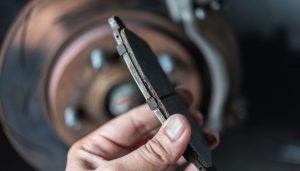Regular inspection of your brake pads is crucial for maintaining safe braking performance and avoiding costly repairs. However, many drivers hesitate to check their brake pads because they think it requires removing the wheels — a task that can be time-consuming, require special tools, and sometimes needs a mechanic. The good news is: you can inspect your brake pads without taking off the wheel in many cases.
In this article, we’ll guide you step-by-step on how to visually check your brake pads through the wheel openings, explain what signs to look for, and share tips for assessing pad thickness and condition. Understanding how to do this quick inspection can help you catch brake wear early and keep your car stopping safely.
Why Inspect Brake Pads Regularly?

Brake pads are a critical component that absorbs friction to slow down your vehicle. Worn-out pads reduce braking efficiency, increase stopping distances, and can damage rotors if left unattended.
Benefits of regular inspection:
-
Avoid sudden brake failure
-
Prevent rotor damage and costly repairs
-
Maintain optimal braking performance
-
Ensure road safety for you and others
Tools You’ll Need for a Brake Pad Inspection
| Tool | Purpose | Optional? |
|---|---|---|
| Flashlight | Illuminate brake components inside wheel | Recommended |
| Tire pressure gauge | Remove valve stem cap (optional for wheel removal) | No (if removing wheel) |
| Brake cleaner | Clean visible brake dust (optional) | Optional |
| Mirror on telescopic handle | Inspect hard-to-see areas | Optional |
For most inspections without wheel removal, just a flashlight is usually sufficient.
Step-by-Step Guide to Inspect Brake Pads Without Removing the Wheel
Step 1: Park Your Car Safely
-
Park on a flat surface
-
Engage the parking brake
-
Turn off the engine and remove the keys
Step 2: Locate the Brake Pads Through the Wheel
Brake pads are visible through the gaps in alloy wheels or behind the wheel spokes of steel wheels. Look between the spokes for the brake caliper and the brake pads pressing against the rotor.
Step 3: Shine a Flashlight Inside the Wheel
Illuminate the brake rotor and caliper area to get a clearer view of the brake pads.
Step 4: Identify the Brake Pad Material
Look for the friction material lining inside the caliper that presses on the rotor. This is the brake pad.
Step 5: Estimate Pad Thickness
Brake pads typically start around 10-12 mm thick (including backing plate). Most manufacturers recommend replacement once the friction material reaches about 3 mm.
If you see the pad material is thin or nearly gone, it’s time for replacement.
How to Interpret What You See: Signs of Wear and Damage
| Visual Indicator | What It Means | Action Needed |
|---|---|---|
| Pad thickness > 5 mm | Pads in good condition | No immediate action needed |
| Pad thickness 3-5 mm | Pads getting thin | Plan replacement soon |
| Pad thickness < 3 mm | Pads worn out | Replace immediately |
| Uneven wear | Possible caliper or suspension issue | Have a mechanic inspect |
| Cracks or chunks missing | Pad is damaged or contaminated | Replace brake pads |
| Excessive dust buildup | Normal to a point; excessive dust can indicate wear | Clean and monitor |
Tips for Inspecting Brake Pads Without Removing Wheels
-
Use a mirror: A small mirror on a telescoping handle helps see hard-to-view areas.
-
Check both front and rear wheels: Pads wear differently depending on drive type.
-
Listen for brake noises: Squealing or grinding often indicates worn pads.
-
Check brake fluid: Low brake fluid can indicate worn pads or leaks.
-
Consult your car’s manual: Recommended inspection intervals and pad thickness vary.
When Wheel Removal is Necessary
If your wheels have small spokes or steel rims with limited gaps, visual inspection through the wheel may be difficult. Removing the wheel will give a much clearer view and is recommended if:
-
You cannot see the pads well through the wheel.
-
You suspect uneven pad wear or damage.
-
You hear unusual noises or feel vibration when braking.
-
Your vehicle has a drum brake system at the rear (requires more work).
Brake Pad Thickness Chart: Visual Guide
| Pad Thickness (mm) | Brake Pad Condition | Suggested Action |
|---|---|---|
| 10-12 | New or nearly new | No action needed |
| 5-7 | Moderate wear | Monitor regularly |
| 3-5 | Near replacement needed | Schedule replacement soon |
| <3 | Critical wear | Replace immediately |
How Often Should You Inspect Your Brake Pads?
| Driving Condition | Recommended Inspection Interval |
|---|---|
| Normal city/highway | Every 10,000 km or 6 months |
| Heavy towing/load | Every 5,000-8,000 km |
| Off-road or dusty areas | Every 5,000 km |
What To Do If You Find Worn Brake Pads

-
Replace with quality brake pads: Always use brake pads matching your car’s specifications.
-
Check rotors: Inspect for grooves, warping, or damage. Resurface or replace if necessary.
-
Inspect calipers and hardware: Ensure proper function and lubrication.
-
Professional brake service: If unsure, have a mechanic diagnose and replace parts safely.
Buy Quality Brake Pads Online
When it’s time to replace your pads, choose from trusted brands and materials tailored for your vehicle and driving style. For a wide selection of reliable, high-quality brake pads:
Buy Car Brake Pads — shop ceramic, semi-metallic, and organic brake pads with confidence.
Summary Checklist: Inspect Brake Pads Without Removing Wheels
-
Park safely on a flat surface
-
Use a flashlight to illuminate through wheel spokes
-
Locate caliper and pad friction material
-
Estimate pad thickness (aim for > 3 mm)
-
Look for uneven wear, damage, or cracks
-
Monitor dust buildup and brake noise
-
Inspect regularly per driving conditions
-
Remove wheels or seek professional help if visual inspection is insufficient
Final Thoughts
Inspecting your brake pads without removing the wheels is a quick and effective way to keep an eye on a vital safety component. While this method doesn’t replace full brake system maintenance, it helps you identify when professional service or replacement is due.
Regular visual checks, combined with paying attention to brake sounds and performance, ensure your brakes stay in top condition — helping you stop safely every time.
If you’re ready to replace worn brake pads, browse and order quality parts online at Buy Car Brake Pads. Your safety starts with reliable brakes!